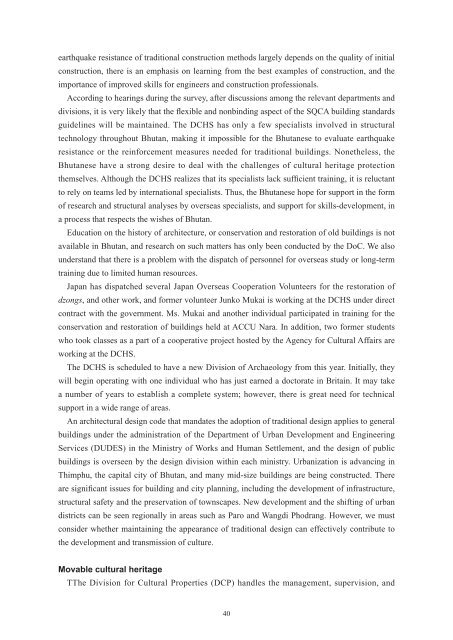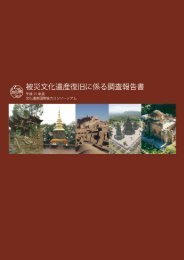English - JCIC-Heritage
English - JCIC-Heritage
English - JCIC-Heritage
Create successful ePaper yourself
Turn your PDF publications into a flip-book with our unique Google optimized e-Paper software.
earthquake resistance of traditional construction methods largely depends on the quality of initial<br />
construction, there is an emphasis on learning from the best examples of construction, and the<br />
importance of improved skills for engineers and construction professionals.<br />
According to hearings during the survey, after discussions among the relevant departments and<br />
divisions, it is very likely that the flexible and nonbinding aspect of the SQCA building standards<br />
guidelines will be maintained. The DCHS has only a few specialists involved in structural<br />
technology throughout Bhutan, making it impossible for the Bhutanese to evaluate earthquake<br />
resistance or the reinforcement measures needed for traditional buildings. Nonetheless, the<br />
Bhutanese have a strong desire to deal with the challenges of cultural heritage protection<br />
themselves. Although the DCHS realizes that its specialists lack sufficient training, it is reluctant<br />
to rely on teams led by international specialists. Thus, the Bhutanese hope for support in the form<br />
of research and structural analyses by overseas specialists, and support for skills-development, in<br />
a process that respects the wishes of Bhutan.<br />
Education on the history of architecture, or conservation and restoration of old buildings is not<br />
available in Bhutan, and research on such matters has only been conducted by the DoC. We also<br />
understand that there is a problem with the dispatch of personnel for overseas study or long-term<br />
training due to limited human resources.<br />
Japan has dispatched several Japan Overseas Cooperation Volunteers for the restoration of<br />
dzongs, and other work, and former volunteer Junko Mukai is working at the DCHS under direct<br />
contract with the government. Ms. Mukai and another individual participated in training for the<br />
conservation and restoration of buildings held at ACCU Nara. In addition, two former students<br />
who took classes as a part of a cooperative project hosted by the Agency for Cultural Affairs are<br />
working at the DCHS.<br />
The DCHS is scheduled to have a new Division of Archaeology from this year. Initially, they<br />
will begin operating with one individual who has just earned a doctorate in Britain. It may take<br />
a number of years to establish a complete system; however, there is great need for technical<br />
support in a wide range of areas.<br />
An architectural design code that mandates the adoption of traditional design applies to general<br />
buildings under the administration of the Department of Urban Development and Engineering<br />
Services (DUDES) in the Ministry of Works and Human Settlement, and the design of public<br />
buildings is overseen by the design division within each ministry. Urbanization is advancing in<br />
Thimphu, the capital city of Bhutan, and many mid-size buildings are being constructed. There<br />
are significant issues for building and city planning, including the development of infrastructure,<br />
structural safety and the preservation of townscapes. New development and the shifting of urban<br />
districts can be seen regionally in areas such as Paro and Wangdi Phodrang. However, we must<br />
consider whether maintaining the appearance of traditional design can effectively contribute to<br />
the development and transmission of culture.<br />
Movable cultural heritage<br />
TThe Division for Cultural Properties (DCP) handles the management, supervision, and<br />
40




